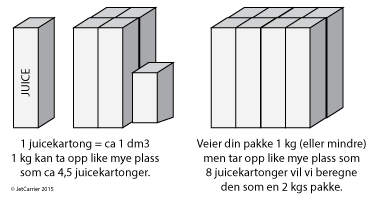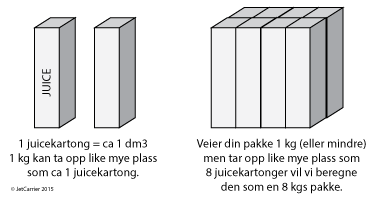Any business that carries goods, needs to calculate both volume and weight. The volume may also dictate the terms of pricing. JetCarrier operates with a 1:4.5 factor on Air Freight and 1:1 on Sea Freight. Basicly this means that an air package may have a volume that is 4.5x bigger than its actual weight. For Sea Freight, we have no factor and 1 kg = 1 dm3.
How much is 1 dm3?
1 dm3 equals approx. 1 liter of water. Imagine a juice box that’s 1 liter; it weighs approx. 1 kg and its volume is of course 1 liter (= 1 dm3). This means that you can send an Air Freight package with a weight of 1 kg and a volume of 4 liters (4 dm3) for the price of 1 kg according to our Price List. See below for given examples of both Air and Sea Freight:

Weight and volume on Air Freight

Weight and volume on Sea Freight
Why can you not just use actual weight when invoicing?
This would of course have been the easiest solution for our customers, but it has some serious negative side effects. Some items barely have any weight vs. its volume. A pillow may only weigh 100 grams but takes a lot of space. If we sent 10,000 pillows, we would most likely fill up the airplane’s cargo space, but only pay for 1,000 kg worth of freight. So in the end, the conclusion is: Volume is also a freight-related cost.




